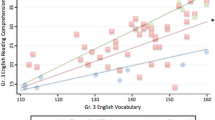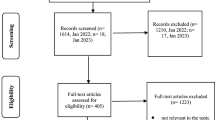Abstract
Reading comprehension performance is predicted by decoding skill and linguistic comprehension (e.g., Hoover & Gough, 1990; Joshi & Aaron, 2012; Scarborough, 2001). However, the type of strategies that readers recruit to build a discourse should also contribute to success in first and second language reading comprehension. Sixty-six French immersion elementary students were assessed in English and French on (1) language proficiency measures, and (2) reported strategy selection during a reading comprehension task. Although students reported different strategy use in each language, similar strategies (e.g., inferencing and reliance on text structure) accounted for reading comprehension performance in English and French. These strategies explained unique variance in addition to language measures, suggesting that reliance on these strategies either reflects greater understanding of the text or enables the reader to better consolidate the text into memory for later retrieval.

Similar content being viewed by others
Notes
These students had English vocabulary scores within 1.5 standard deviations of the group mean.
There is a French version of the PPVT (known as the Échelle de Vocabulaire en Images Peabody; Dunn, Thériault-Whalen, & Dunn, 1993). It was not used because several items are French–English cognates (~ 33%) and the sets do not increase in difficulty like the PPVT.
Vocabulary was removed from the analysis given that it was only identified twice as a strategy in English.
References
Aarts, R., & Verhoeven, L. (1999). Literacy attainment in second language submersion context. Applied Psycholinguistics,20, 377–393.
Afflerbach, P., Pearson, P. D., & Paris, S. G. (2008). Clarifying differences between reading skills and reading strategies. The Reading Teacher,61, 364–373. https://doi.org/10.1598/RT.61.5.1.
Allen, M. J., & Yen, W. M. (1979). Introduction to measurement theory. Monterey, CA: Brooks/Cole.
Anastasiou, D., & Griva, E. (2009). Awareness of reading strategy use and reading comprehension among poor and good readers. Elementary Education Online,8, 283–297.
Anderson, J. A. E., Mak, L., Chahi, A., & Bialystok, E. (2018). The language and social background questionnaire: Assessing degree of bilingualism in a diverse population. Behavior Research Methods,50, 250–263. https://doi.org/10.3758/s13428-017-0867-9.
AuYeung, K., Hipfner-Boucher, K., Chen, X., Pasquarella, A., D’Angelo, N., & Deacon, H. (2014). Development of English and French language and literacy skills in EL1 and EL French immersion students in the early grades. Reading Research Quarterly,50, 233–254. https://doi.org/10.1002/rrq.95.
Blachowicz, C., & Ogle, D. (2017). Reading comprehension: Strategies for independent learners. New York: Guilford Publications.
Cain, K. (2010). Reading development and difficulties. Toronto: Wiley-Blackwell.
Cain, K., & Oakhill, J. V. (1999). Inference making and its relation to comprehension failure. Reading and Writing,11, 489–503.
Calisir, F., & Gurel, Z. (2003). Influence of text structure and prior knowledge of the learner on reading comprehension, browsing and perceived control. Computers in Human Behavior,19, 135–145. https://doi.org/10.1016/S0747-5632(02)00058-4.
Carrell, P. L., Pharis, B. G., & Liberto, J. C. (1989). Metacognitive strategy training for ESL reading. TESOL Quarterly,33, 647–678.
Cashion, M., & Eagan, R. (1990). Spontaneous reading and writing in English by students in total French immersion: Summary of final report. English Quarterly,22, 30–44.
Coiro, J., & Dobler, E. (2007). Exploring the online reading comprehension strategies used by sixth-grade skilled readers to search for and locate information on the Internet. Reading Research Quarterly,42, 214–257. https://doi.org/10.1598/RRQ.42.2.2.
Cooper, J. O., Heron, T. E., & Heward, W. L. (2007). Applied behavior analysis (2nd ed.). Columbus, OH: Pearson.
Cummins, J. (1998). Immersion education for the millennium: What have we learned from 30 years of research on second language immersion? In M. R. Childs & R. M. Bostwick (Eds.) Learning through two languages: Research and practice. Second Katoh Gakuen international symposium on immersion and bilingual education (pp. 34–47). Katoh Gakuen, Japan.
Cummins, J. (2014). To what extent are Canadian second language policies evidence-based? Reflections on the intersections of research and policy. Frontiers in Psychology,5, 358. https://doi.org/10.3389/fpsyg.2014.00358.
Duke, N. K., & Pearson, P. D. (2009). Effective practices for developing reading comprehension. Journal of Education,189, 107–122. https://doi.org/10.1177/0022057409189001-208.
Dunn, L. M., & Dunn, L. M. (1997). Examiner’s manual for the PPVT-III peabody picture vocabulary test: Form IIIA and Form IIIB. AGS.
Dunn, L. M., Thériault-Whalen, C. M., & Dunn, L. M. (1993). Echelle de vocabulaire en images Peabody. Adaptation française du Peabody Picture Vocabulary Test. Toronto, Canada: Psycan.
Erdos, C., Genesee, F., Savage, R., & Haigh, C. A. (2010). Individual differences in second language reading outcomes. International Journal of Bilingualism,15(1), 3–25. https://doi.org/10.1177/1367006910371022.
Erfani, S. M., Iranmehr, A., & Davari, H. (2011). Deepening ESP reading comprehension through visualization. Journal of Language Teaching and Research,2, 270–273. https://doi.org/10.4304/jltr.2.1.270-273.
Friesen, D. C., & Haigh, C. A. (2018). How and why strategy instruction can improve second language reading comprehension: A review. The Reading Matrix: An International Online Journal,18, 1–18.
Friesen, D. C., & Jared, D. (2007). Cross-language message- and word-level transfer effects in bilingual text processing. Memory and Cognition,35(7), 1542–1556. https://doi.org/10.3758/BF03193489.
Fuchs, L. S., Fuchs, D., Hosp, M. K., & Jenkins, J. R. (2001). Oral reading fluency as an indicator of reading competence: A theoretical, empirical, and historical analysis. Scientific Studies of Reading,5, 239–256. https://doi.org/10.1207/S1532799XSSR0503_3.
Genesee, F. (1978). Scholastic effects of French immersion: An overview after ten years. Interchange,9(4), 20–29.
Genesee, F., & Jared, D. (2008). Literacy development in early French immersion programs. Canadian Psychology/Psychologie Canadienne,49, 140–147. https://doi.org/10.1037/0708-5591.49.2.140.
Geva, E., & Clifton, S. (1994). The development of first and second language reading skills in early French immersion. The Canadian Modern Language Review,50, 646–667. https://doi.org/10.3138/cmlr.50.4.646.
Geva, E., & Farnia, F. (2012). Developmental changes in the nature of language proficiency and reading fluency paint a more complex view of reading comprehension in ELL and EL1. Reading and Writing,25, 1819–1845.
Gough, P. B., & Tunmer, W. E. (1986). Decoding, reading, and reading disability. RASE,7, 6–10.
Hoover, W. A., & Gough, P. B. (1990). The simple view of reading. Reading and Writing,2, 127–160. https://doi.org/10.1007/BF00401799.
Jairam, D., Kiewra, K. A., Rogers-Kasson, S., Patterson-Hazley, M., & Marxhausen, K. (2014). SOAR versus SQ3R: A test of two study systems. Instructional Science,42(3), 409–420. https://doi.org/10.1007/s11251-013-9295-0.
Jared, D., Cormier, P., Levy, B. A., & Wade-Woolley, L. (2011). Early predictors of biliteracy development in children in French immersion: A 4-year longitudinal study. Journal of Educational Psychology,103, 119–139. https://doi.org/10.1037/a0021284.
Jiménez, R. T., García, G. E., & Pearson, P. D. (1996). The reading strategies of bilingual Latina/o students who are successful English readers: Opportunities and obstacles. Reading Research Quarterly,31, 90–112. https://doi.org/10.1598/RRQ.31.1.5.
Johnson-Laird, P. (1983). Mental models. Cambridge, MA: Harvard University Press.
Joshi, R. M., & Aaron, P. G. (2000). The component model of reading: Simple view of reading made a little more complex. Reading Psychology,21(2), 85–97. https://doi.org/10.1080/02702710050084428.
Joshi, R. M., & Aaron, P. G. (2012). Componential model of reading (CMR): Validation studies. Journal of Learning Disabilities,45(5), 387–390. https://doi.org/10.1177/0022219411431240.
Kendeou, P., & Van Den Broek, P. (2007). The effects of prior knowledge and text structure on comprehension processes during reading of scientific texts. Memory and Cognition,35(7), 1567–1577.
Kolić-Vehovec, S., & Bajśanski, I. (2007). Comprehension monitoring and reading comprehension in bilingual students. Journal of Research in Reading,30, 198–211.
Lee, K., & Chen, X. (2018). An emergent interaction between reading fluency and vocabulary in the prediction of reading comprehension among French immersion elementary students. Reading and Writing: An Interdisciplinary Journal. https://doi.org/10.1007/s11145-018-9920-z.
Lindholm-Leary, K., & Genesee, F. (2014). Student outcomes in one-way, two-way, and indigenous language immersion education. Journal of Immersion and Content-Based Language Education,2, 165–180. https://doi.org/10.1075/jicb.2.2.01lin.
Malicky, G. V., Fagan, W. T., & Norman, C. A. (1988). Reading processes of French immersion children reading in French and English. Canadian Journal of Education,13, 277–289. https://doi.org/10.2307/1494956.
McClellan, K. A. (2009). French immersion students’ perceptions towards reading in French. Doctoral dissertation. Vancouver: University of British Columbia.
McNamara, D. S. (2012). Reading comprehension strategies: Theories, interventions, and technologies. New York: Lawrence Erlbaum Associates.
Melby-Lervåg, M., & Lervåg, A. (2014). Reading comprehension and its underlying components in second-language learners: A meta-analysis of studies comparing first-and second-language learners. Psychological Bulletin,140, 409. https://doi.org/10.1037/a0033890.
Meyer, B. J. F., & Freedle, R. O. (1984). Effects of discourse type on recall. American Educational Research Journal,21, 121–143. https://doi.org/10.3102/00028312021001121.
Muijselaar, M. M. L., Swart, N. M., Steenbeek-Planting, E. G., Droop, M., Verhoeven, L., & de Jong, P. F. (2017). Developmental relations between reading comprehension and reading strategies. Scientific Studies of Reading,21, 194–209. https://doi.org/10.1080/10888438.2017.1278763.
Oakhill, J., & Cain, K. (2007). Issues of causality in children’s reading comprehension. In D. S. McNamara (Ed.), Reading comprehension strategies: Theories, interventions, and technologies (pp. 47–72). New York: Lawrence Erlbaum Associates.
Oakhill, J., & Cain, K. (2012). The precursors of reading ability in young readers: Evidence from a four-year longitudinal study. Scientific Studies of Reading,16, 91–121.
Park, J. Y. (2012). A different kind of reading instruction: Using visualizing to bridge reading comprehension and critical literacy. Journal of Adolescent and Adult Literacy,55, 629–640. https://doi.org/10.1002/JAAL.00074.
Pawley, C. (1985). How bilingual are French immersion students? Canadian Modern Language Review,41(5), 865–876.
Pressley, M. (2000). What should comprehension instruction be the instruction of? In M. L. Kamil, P. B. Mosenthal, P. D. Pearson, & R. Barr (Eds.), Handbook of reading research (Vol. III, pp. 545–561). Mahwah, NJ: Lawrence Earlbaum Associates Inc.
Proctor, C. P., August, D., Carlo, M. S., & Snow, C. E. (2006). The intriguing role of Spanish language vocabulary knowledge in predicting English reading comprehension. Journal of Educational Psychology,98(1), 159–169.
Rand Reading Study Group. (2002). Reading for understanding: Toward an R&D program in reading comprehension. Santa Monica, CA: RAND.
Romney, J. C., Romney, D., & Menzies, H. (1994). What and how much do immersion children read for pleasure. Journal de l’immersion/Immersion Journal,17, 7–15.
Rumelhart, D. E. (1977). Introduction to human information processing. New York: Wiley.
Savage, R., & Pace, A. (2019). Linguistic and reading comprehension in simultaneous dual language instruction: Evidence against unitary constructs. International Journal of Bilingualism,23(1), 118–137.
Scarborough, H. (2001). Connecting early language and literacy to later reading (dis)abilities: Evidence, theory and practice. In S. B. Neuman & D. K. Dickinson (Eds.), Handbook of early literacy research (Vol. 1, pp. 97–110). New York, NY: Guilford Press.
Stanovich, K. E. (1980). Toward an interactive-compensatory model of individual differences in the development of reading fluency. Reading Research Quarterly,16, 32–71. https://doi.org/10.2307/747348.
Statistics Canada. (2017). Elementary-secondary education survey for Canada, the provinces and territories, 2015/2016. Statistics Canada Catalogue no. 11-001-X. Ottawa. Version updated November 2017. Ottawa. https://www150.statcan.gc.ca/n1/daily-quotidien/171103/dq171103c-eng.htm (May 23, 2018).
Storch, S. A., & Whitechurst, G. J. (2002). Oral language and code-related precursors to reading. Evidence from a longitudinal model. Developmental Psychology,38, 934–947.
Torgesen, J. K., Wagner, R. K., & Rashotte, C. A. (1999). Test of word reading efficiency (TOWRE). Austin, TX: Pro-ed.
Turnbull, M., Lapkin, S., & Hart, D. (2001). Grade 3 immersion students’ performance in literacy and mathematics: Province-wide results from Ontario (1998–99). Canadian Modern Language Review,58(1), 9–26.
Uhl-Chamot, A., & El-Dinary, P. B. (1999). Children’s learning strategies in language immersion classrooms. The Modern Language Journal,83, 319–338. https://doi.org/10.1111/0026-7902.00025.
Wiederholt, J. L., & Bryant, B. R. (2001). Gray oral reading tests (4th ed.). Austin, TX: Pro-Ed.
Wolf, M., & Katzir-Cohen, T. (2001). Reading fluency and its intervention. Scientific Studies of Reading,5, 211–239. https://doi.org/10.1207/S1532799XSSR0503_2.
Yuill, N. M., & Oakhill, J. V. (1988). Effects of inference awareness training on poor reading comprehension. Applied Cognitive Psychology,2, 33–45.
Acknowledgements
This work was supported by the Western Faculty Research Development Grant (R5539A03) to DF. We wish to thank Kayla Edwards for her help with data analysis.
Author information
Authors and Affiliations
Corresponding author
Additional information
Publisher's Note
Springer Nature remains neutral with regard to jurisdictional claims in published maps and institutional affiliations.
Rights and permissions
About this article
Cite this article
Frid, B., Friesen, D.C. Reading comprehension and strategy use in fourth- and fifth-grade French immersion students. Read Writ 33, 1213–1233 (2020). https://doi.org/10.1007/s11145-019-10004-5
Published:
Issue Date:
DOI: https://doi.org/10.1007/s11145-019-10004-5




